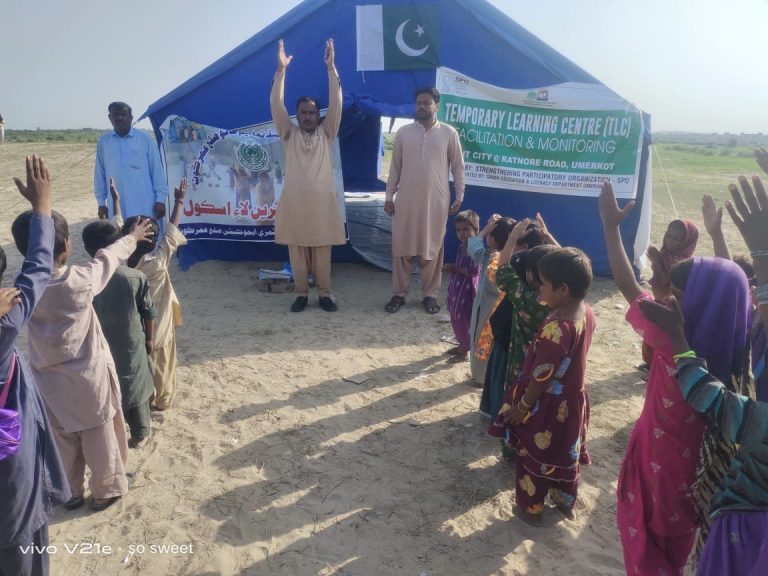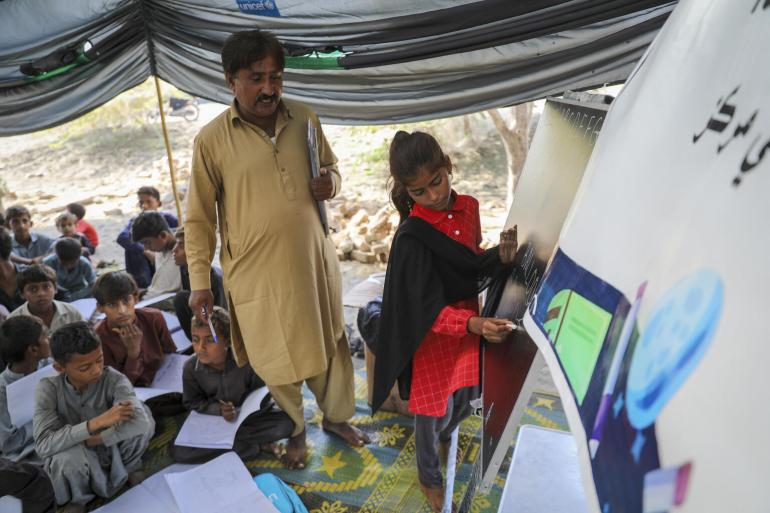
It is difficult to predict the success of this project without specific details of the plan and the resources however, there are a few factors that could potentially impact the success of the project.
Dr. Kamran Hussain Brohi
A recent media report suggests that Sindh government has decided to establish 20,000 tent schools in flood-affected areas. The Provincial Rehabilitation Department has requisitioned Rs.3.60 billion from the finance department for buying the tents at the rate of Rs.180, 000 per tent. The report further suggests that 7503 schools were completely destroyed while 12305 schools were partially damaged.
Let’s discuss what the Tent School is? And what could be the probabilities of the success of this project?
A tent school is a type of temporary educational facility that is set up in a tent or other temporary structure, typically in areas where there is a lack of permanent school buildings. These types of schools are often used in disaster-stricken areas, refugee camps, or other locations where people are displaced or living in temporary housing. They can also be used as a temporary solution when a permanent school is undergoing renovations or construction. Tent schools typically have basic facilities, such as desks, chairs, and a blackboard, and may be staffed by volunteer teachers or aid workers.
There are many examples of tent schools being set up around the world in response to a variety of situations. Some examples include:
- In the aftermath of natural disasters, such as earthquakes, hurricanes, and tsunamis, tent schools are often set up to provide education for children in affected areas while permanent schools are being rebuilt.
- In refugee camps, tent schools are used to provide education for children who have been displaced from their homes due to war or other crises. These schools are often run by NGOs or UN agencies and may provide both formal and non-formal education.
- In developing countries, tent schools may be used as a temporary solution for communities that lack permanent school buildings. These schools may be set up by NGOs, government agencies, or local organizations and may be staffed by volunteer teachers.
- In some cases, tent schools are also set up as a temporary solution when a permanent school is undergoing renovations or construction. This allows students to continue attending classes while the work is being done.
Overall, Tent schools have been used in many different contexts around the world, and have been an important way to ensure that children in affected areas have access to education.
Here are a few examples of case studies of tent schools around the world:
- In Nepal, tent schools were set up after the 2015 earthquakes to provide education for children in affected areas. These schools were run by local NGOs and international organizations, and were staffed by volunteer teachers. The tent schools provided a temporary solution for children who were unable to attend classes in damaged or destroyed schools.
- In Syria, tent schools have been set up in refugee camps to provide education for children who have been displaced by the ongoing civil war. These schools are run by NGOs and UN agencies and provide both formal and non-formal education. They often use a curriculum that is relevant to the context of the refugee camps, and teachers may be trained in providing education in emergency situations.
- In Haiti, tent schools were set up after the 2010 earthquake to provide education for children in affected areas. The tent schools were set up by NGOs and international organizations, and were staffed by local teachers. The schools provided a temporary solution for children who were unable to attend classes in damaged or destroyed schools.
- In Bangladesh, tent schools were set up to provide education for Rohingya children living in refugee camps. The schools were run by NGOs and UN agencies, and provided both formal and non-formal education. The teachers in these schools were trained to provide education in emergency situations, and the curriculum was designed to be relevant to the context of the refugee camps.
These are just a few examples of tent schools around the world, but many other countries have also set up tent schools in response to emergencies or other situations.
Here are a few examples of case studies of tent schools in Pakistan:
- In the aftermath of the 2005 earthquake in Pakistan, tent schools were set up to provide education for children in affected areas. These schools were run by NGOs and international organizations and were staffed by volunteer teachers. The tent schools provided a temporary solution for children who were unable to attend classes in damaged or destroyed schools.
- In flood-affected areas of Pakistan, tent schools have been set up to provide education for children who have been displaced by the flooding. These schools are run by NGOs, local organizations, and government agencies and provide both formal and non-formal education.
- In Balochistan province of Pakistan, tent schools have been set up to provide education for children in areas where there is a lack of permanent school buildings. These schools are run by NGOs and government agencies, and are staffed by volunteer teachers.
- In the aftermath of the 2010 floods in Pakistan, tent schools were set up to provide education for children in affected areas. These schools were run by NGOs and international organizations, and were staffed by local teachers. The tent schools provided a temporary solution for children who were unable to attend classes in damaged or destroyed schools.

Overall, Tent schools have been used in many different contexts in Pakistan, and have been an important way to ensure that children in affected areas have access to education, especially in areas with a lack of permanent schools or in aftermath of natural disasters.
Recently, The Sindh government has decided to resume academic activities in public sector schools situated in flood-affected areas across the province. What is the probability of success of this project?
It is difficult to predict the exact probability of success for this project without more information about the specific details of the plan and the resources that the Sindh government has allocated for it. However, there are a few factors that could potentially impact the success of the project:
- Availability of resources: Resuming academic activities in flood-affected areas will require resources such as school buildings, teachers, and educational materials. If the Sindh government has secured these resources and made them available to schools in affected areas, it is more likely that the project will be successful.
- Accessibility of schools: Flooding can make it difficult for children to reach schools, so the Sindh government will need to ensure that the schools are accessible and that transportation is provided for children.
- Support for teachers and students: Teachers and students in affected areas may have experienced trauma and loss, so it is important that the Sindh government provides support for their well-being in order for the project to be successful.
- Monitoring and evaluation: The Sindh government will need to monitor the progress of the project and evaluate its success in order to make any necessary adjustments and improvements.
Overall, it is important that the Sindh government has a comprehensive plan and has made necessary resources available, provides support and assistance to those affected by the flood, and continuously evaluate and make changes to the project for it to have a higher probability of success.
International educational communities and donor agencies can help to make the project of resuming academic activities in public sector schools situated in flood-affected areas in Sindh, Pakistan a successful one by providing the following types of support:
- Funding: Donor agencies can provide financial support to help with the costs of rebuilding and repairing schools, as well as purchasing educational materials and providing transportation for children.
- Technical assistance: International educational communities can provide technical assistance to help with planning and implementing the project. This could include providing expertise in areas such as curriculum development, teacher training, and monitoring and evaluation.
- Educational materials: Donor agencies and international educational communities can provide educational materials such as textbooks, learning aids, and technology to help support learning in affected areas.
- Support for teachers and students: International educational communities can provide support for teachers and students by providing psychological and emotional support, as well as training on how to provide education in emergency situations.
- Collaboration: International educational communities and donor agencies can collaborate with the Sindh government, NGOs and other stakeholders working in the field to ensure that the project is well coordinated and that resources are used effectively.
- Monitoring and Evaluation: International educational communities and donor agencies can provide support for monitoring and evaluating the project, to ensure that it is meeting its objectives and to identify areas for improvement.
Overall, the support of international educational communities and donor agencies can be a vital to ensure that the project of resuming academic activities in flood-affected areas of Sindh is well-coordinated, well-funded, and sustainable.
________________
Dr. Kamran Hussain Brohi is an educationist, researcher and public procurement expert. He can be accessed at email: kamran@usindh.edu.pk